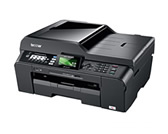MFC-J6510DW
FAQs & Troubleshooting |
What is the recommended paper?
You can use the following types of print media: plain paper, inkjet paper (coated paper), glossy paper, transparencies and envelopes.
Print quality may vary according to the type of paper you are using. For best results, follow the instructions below:
- When you print on inkjet paper (coated paper), transparencies and glossy paper, be sure to choose the proper print media in the Basic tab of the printer driver or in the Paper Type setting of the machine's menu.
- When you print on Brother Photo paper, load one extra sheet of the same photo paper in the paper tray. An extra sheet has been included in the paper package for this purpose.
- When you use transparencies or photo paper, remove each sheet at once to prevent smudging or paper jams.
- Avoid touching the printed surface of the paper immediately after printing; the surface may not be completely dry and may stain your fingers.
Paper size supported by the paper trays
| Paper size | |
|---|---|
| Tray#1 | A4, Ledger, A3, Legal, Executive, Letter, A5, A6, JIS B4, JIS B5, Envelopes (commercial No. 10, DL, C5, Monarch, Y4), Photo, Photo L, Photo 2L, Index Card, Postcard 1, Postcard 2 |
| Tray#2 (For models with second paper tray) |
A4, Ledger, A3, Legal, Executive, Letter, JIS B4, JIS B5 |
| Manual Feed Slot | A4, Ledger, A3, Legal, Executive, Letter, A5, A6, JIS B4, JIS B5, Envelopes (commercial No. 10, DL, C5, Monarch, Y4), Photo, Photo L, Photo 2L, Index Card, Postcard 1, Postcard 2 |
Paper specifications and capacity of the paper trays
Tray#1
| Paper Type | Weight | Thickness | No. of sheets |
|---|---|---|---|
| Plain Paper | 64 to 120 g/m2 (17 to 32 lb) | 0.08 to 0.15 mm (3 to 6 mil) | Up to 250 sheets*1 |
| Inkjet Paper | 64 to 200 g/m2 (17 to 53 lb) | 0.08 to 0.25 mm (3 to 10 mil) | Up to 20 sheets |
| Glossy Paper*2, Photo |
Up to 220 g/m2 (Up to 58 lb) | Up to 0.25 mm (Up to 10 mil) | Up to 20 sheets |
| Index Card | Up to 120 g/m2 (Up to 32 lb) | Up to 0.15 mm (Up to 6 mil) | Up to 30 sheets |
| Postcard | Up to 200 g/m2 (Up to 53 lb) | Up to 0.25 mm (Up to 10 mil) | Up to 30 sheets |
| Envelopes | 75 to 95 g/m2 (20 to 25 lb) | Up to 0.52 mm (Up to 20 mil) | Up to 10 sheets |
| Transparencies | - | - | Up to 10 sheets |
*2: BP71 (260 g/m2 (69 lb)) paper is especially designed for Brother inkjet machines.
Tray#2 (For models with second paper tray)
| Paper Type | Weight | Thickness | No. of sheets |
|---|---|---|---|
| Plain Paper | 64 to 105 g/m2 (17 to 28 lb) | 0.08 to 0.15 mm (3 to 6 mil) | Up to 250 sheets*1 |
Manual Feed Slot
| Paper Type | Weight | Thickness | No. of sheets |
|---|---|---|---|
| Plain Paper | 64 to 120 g/m2 (17 to 32 lb) | 0.08 to 0.15 mm (3 to 6 mil) | One (1) sheet at a time |
| Inkjet Paper | 64 to 200 g/m2 (17 to 53 lb) | 0.08 to 0.25 mm (3 to 10 mil) | |
| Glossy Paper*1, Photo |
Up to 220 g/m2 (Up to 58 lb) | Up to 0.25 mm (Up to 10 mil) | |
| Envelopes | 75 to 95 g/m2 (20 to 25 lb) | Up to 0.52 mm (Up to 20 mil) | |
| Transparencies | - | - | |
| Labels | - | - |
Notes for 2-sided (duplex) printing
You can only use plain paper.
- Sizes: A4, Ledger, A3, Legal, Executive, Letter, A5, A6, JIS B4, JIS B5
- Weight: 64 to 105 g/m2 (17 to 28 lb)
- Thickness: 0.08 to 0.15 mm (3 to 6 mil)
Notes for handling and using print media
- Store paper in its original packaging and keep it sealed.
- Keep the paper flat and away from moisture, direct sunlight and heat.
- Avoid touching the shiny (coated) side of photo paper. Load photo paper with the shiny side facing down.
- Avoid touching either side of transparencies because they absorb water and perspiration easily, and this may cause decreased output quality. Transparencies designed for laser printers/copies may stain your next document. Use only transparencies recommended for inkjet printing.
Notes for using labels
Labels should be arranged so that they cover the entire length and width of the sheet. Using labels with spaces may result in labels peeling off and causing serious jams or print problems.
DO NOT use the following kinds of paper:
- Damaged, curled, wrinkled, or irregularly shaped
- Extremely shiny or highly textured
- Paper that cannot be arranged uniformly when stacked
- Paper made with a short grain
Content Feedback
To help us improve our support, please provide your feedback below.
